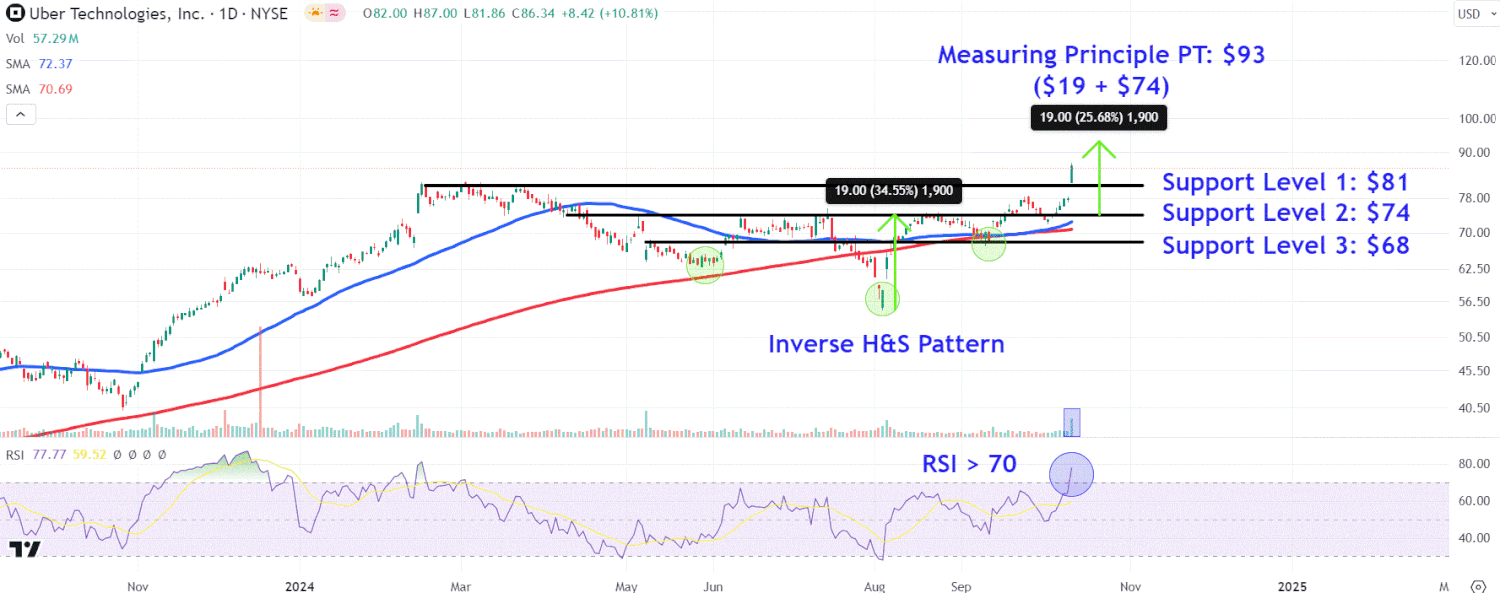Key takeaways
- Uber shares lost ground on Monday but are still near record highs after investors saw little threat to ride-sharing companies from Tesla’s long-awaited unveiling of robot taxis last week.
- A chart-based price target using the measurement principle projects a potential move up to $93, an area where investors may decide to lock in profits.
- Investors should see key support levels on Uber’s chart around $81, $74 and $68.
Shares of Uber Technologies ( UBER ) lost ground Monday but were still near record highs after investors saw little threat to ride-sharing companies from Tesla’s ( TSLA ) long-awaited robot taxi unveiling last week.
Tesla unveiled its long-awaited Cybercab autonomous vehicle and a larger Robovan at an event last Thursday night. Analysts pointed out that the electric car maker provided very little of the details, with no specific business model to indicate how the new line of autonomous vehicles would ultimately compete with companies like Uber and Lyft ( LYFT ).
Since the start of the year, Uber shares are up nearly 40%, in part from its own foray into robotics. In recent months, the company has announced partnerships with General Motors’ ( GM ) self-driving car company Cruise, Alphabet’s ( GOOGL ) autonomous vehicle company Waymo, and startup Wayve.
Uber shares were down 1.6% at $85 by mid-afternoon Monday. The stock hit a record high of $87 on Friday and ended the session 11% higher.
Below, we take a look at the technicals on Uber’s chart and identify key price levels worth watching.
Reverse head and shoulders
Uber shares carved out an inverse head and shoulders pattern on the chart between May and September, with the share price decisively breaking out of the pattern on Friday.
Importantly, the move came on the highest trading volume since early May, signaling buying activity by major market participants.
Furthermore, the Relative Strength Index (RSI) confirms bullish price momentum with a reading above 70, but also warns of overbought conditions, opening the door to short-term profit-taking.
Let’s take a look at a chart-based upside price target and find three key support levels that are likely to attract attention.
Chart based price target to monitor
We can project a price target using the measurement principle, which helps us determine an area on the chart where investors can decide to lock in profits.
To do this, we calculate the distance from the reverse head and shoulder head to the neckline and add this amount to the breakout point.
For example, we add $19 to $74, which predicts a bullish target of $93, which represents an upside of about 8% from Friday’s close.
See these important support levels
During an initial pullback, investors should keep a close eye on the $81 level, where shares could find support near three previous highs that formed on the chart from February to March, an area that is also closely aligned with Friday’s low breakout gap. .
Failure to hold this level could see the stock fall to around $74, a spot on the chart where investors who prefer not to chase breakouts can look for buying opportunities near the neckline of the inverse head and shoulders pattern.
Finally, further selling could lead to a decline to the $68 area, where shares could encounter support around a horizontal line connecting a series of comparable trading levels on the chart between May and September.
The comments, opinions and analysis expressed on Investopedia are for informational purposes only. Read our warranty and disclaimer for more info.
As of the date this article was written, the author does not own any of the above securities.
